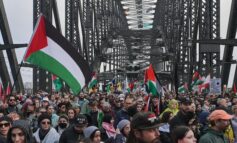
Beginning around 100 BC, the fabled Silk Road brought goods and travelers from China and Central Asia, through the lands of Persia and Mesopotamia, and over to Palmyra in Syria. One branch of the road then turned south, crossing through Bethany, the Biblical village on the outskirts of Jerusalem, as it headed west from Jerusalem to Yoppa (today’s Jaffa) and the Mediterranean Sea.
Today the town of Bethany is known as Abu Dis. It is still on the outskirts of Jerusalem. And the ancient road is still there. Dusty and pothole-filled, it winds through the center of the Palestinian town, with auto-parts yards and small dingy shops selling vegetables and furniture lining both sides. The road then comes to an abrupt stop, blocked by the towering, graffiti-covered cement slabs of Israel’s separation wall.
Today, the Silk Road stops in Abu Dis. The road no longer goes through Jerusalem, and can no longer reach the sea. That grimy, garbage-strewn dead end marks the end of 2,202 years of history.
When Israel first occupied the Palestinian territories in June 1967, Abu Dis was a small, crowded West Bank town outside of Jerusalem. After the war, Israel expanded the municipal borders, and soon expropriated and annexed huge swathes of West Bank Palestinian land into what quickly became known as “Greater Jerusalem.” The heavily populated Palestinian areas were excluded so Israel could insure a 70-30 percent Jewish majority in the city. Most of Abu Dis remained outside.
The Palestinians had long insisted on their right to establish the capital of their future state in Israeli-occupied Arab East Jerusalem. In 2000, in the run-up to the Camp David talks that year, then-Prime Minister Ehud Barak held out what he appeared to believe was a generous offer. Instead of a capital in Jerusalem (“al-Quds” in Arabic), Israel would allow Yasir Arafat to establish the Palestinian capital in Abu Dis. Barak added, as if it were a gift, that Israel would allow the Palestinians raising their flag over the fetid, arid town to “call it al-Quds.” It was as if, in negotiations over New York City, one side offered Newark, and said “we’ll even let you call it New York.”
As the New York Times reported at the time, “Abu Dis looks like a village and, with raw sewage flowing roadside, it smells like a village. No Palestinian will ever mistake Abu Dis for Jerusalem itself. If the Israelis intend it as an alternative capital for the Palestinians state, which is what Mr. Barak seemed to be saying last week, Palestinians find this an insult, a joke and a deal-breaker.”
When Israel began construction of the separation wall in 2002, one of the first sections was built in Abu Dis. Not between Abu Dis and Jerusalem, but within Abu Dis, dividing the town in two. Suddenly students and teachers could not get to school, patients could not get to clinics, no one could go to pray in the mosques of Jerusalem. At first the wall was only eight feet high; just where the road ends today was an unofficial crossing point, where international television crews filmed old women in thobes (traditional embroidered dresses) being half helped/half-hoisted over and across the wall. Today the wall in Abu Dis, as in all of the cities of the West Bank where it snakes through Palestinian land, is eight meters — twenty-four feet — high, and no one climbs over.
In the overall scheme of Palestinian life under occupation, things in Abu Dis could certainly be worse. After all, unemployment across the West Bank is only 49 percent; in the besieged Gaza Strip it tops 79 percent. After all, people in Abu Dis can still move around inside their town (even if they can’t cross the municipal border into Jerusalem), while the 5,000 or so Palestinians of Ni’lin, near Ramallah, recently endured four days and nights of closure and curfew imposed by the Israeli military during nonviolent protests against the separation wall. After all, most people in Abu Dis can at least leave their town most of the time; Qalqilya, a city of 40,000 in the northern West Bank, has been completely encircled by the wall for several years — surrounded, with only one gate.
It could be worse. But residents of Abu Dis were prescient. The separation wall only began construction in 2002. Two years before that, when Israel handed official control of Abu Dis over to the Palestinian Authority, the move “even raised fears among residents that a border fence would be built to separate them from Jerusalem, and that they and the Palestinian people would be left with their noses pressed against the slats — so close and so far away,” as the Times put it. ” ‘We are today closer than ever to Jerusalem,’ said Abdul Rahman al-Shamali, the muezzin who calls Muslims to prayer at one of five mosques in the conservative, religious town. ‘But to be frank, I am sad. I fear that it will end here. I fear that my heart is going to be divided. Jerusalem is my heart.’ ”
They were right. The Palestinians of Abu Dis, or Bethany, are no closer to Jerusalem, despite being able to see al-Aqsa Mosque and the Dome of the Rock from high points within their city.
And dusty, tired Abu Dis is the place where history at last, at least the fabled Silk Road part of history, comes to its end.
Phyllis Bennis is a fellow of the Institute for Policy Studies and author of “Understanding the Palestinian-Israeli Conflict: A Primer.” Copyright © 2008 The Nation.






Leave a Reply